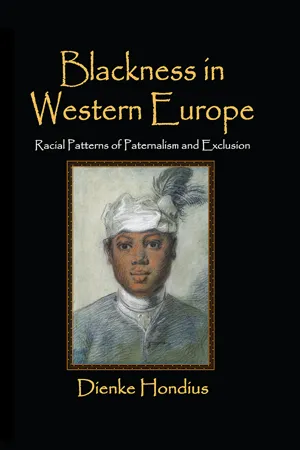
- 362 pages
- English
- ePUB (mobile friendly)
- Available on iOS & Android
About this book
While the study of race relations in the United States continues to inspire and influence European thinking, Europeans have yet to confront their own history. To be black in Europe—whether during the sixteenth century or today—means sharing one crucial experience: being part of a small, but visible minority.
European slave-owners, company directors, and investors in the distant past maintained an ocean-wide gap between themselves and the enslaved in the plantation colonies of the Caribbean. In the following centuries, this distance persisted. Even today, to be black in Europe often means to be one of a few black persons in a group. A racial pattern of exclusion has characterized European policy for more than four centuries.
Dienke Hondius identifies ideas and attitudes toward "blackness, " the concept of race as visible difference, developed in western Europe. She argues that racial discourses are generally dominated by paternalism—a concept usually used to explain power structures that is often applied to the nineteenth century. Hondius identifies five patterns of paternalism that influenced Europe much earlier and iniated trends of imagery and perception.
Taking a chronological and thematic approach, Hondius first focuses on southern European societies in the Early Modern period and moves to northwest European societies in the Modern period. Addressing religion, law, and science, she concludes with a synthesis of developments from the twentieth century to the present.
Frequently asked questions
- Essential is ideal for learners and professionals who enjoy exploring a wide range of subjects. Access the Essential Library with 800,000+ trusted titles and best-sellers across business, personal growth, and the humanities. Includes unlimited reading time and Standard Read Aloud voice.
- Complete: Perfect for advanced learners and researchers needing full, unrestricted access. Unlock 1.4M+ books across hundreds of subjects, including academic and specialized titles. The Complete Plan also includes advanced features like Premium Read Aloud and Research Assistant.
Please note we cannot support devices running on iOS 13 and Android 7 or earlier. Learn more about using the app.
Information
Table of contents
- Cover
- Half Title
- Title
- Copyright
- Contents
- Preface
- Introduction: Long Trends in European Race Relations
- 1. Paternalism, Race, and Racism in European History
- 2. A Convenient Perception: Slavery and the European View of Africans as Children
- 3. Race and Religion: A History of Christian Ambivalence
- 4. European Racial Shows, Collections, and “Science”: Africans as Objects of White Exoticism and Curiosity
- 5. How Europe Remained Mostly White: Maintaining Boundaries, Restricting Access
- 6. Shoah and Empire: Race in Twentieth-Century Europe
- Conclusions: Blackness in Europe: A History of Exceptions
- Acknowledgments
- Index